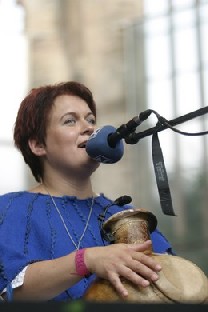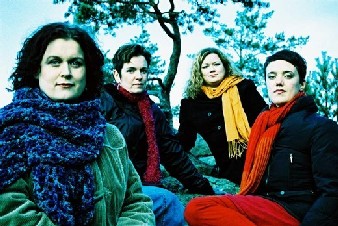FolkWorld Issue 33 05/2007; Article by Eelco Schilder
The Four Elements
Tellu Turka & Suden Aika
Tellu Turkka has a long and successful career in Finnish traditional music. She used to be one of the Hedningarna singers and worked with the group Tallari for several years. Recently she focussed on composing and recorded cd’s with Liisa Matveinen with whom she cooperates in the Suden Aika quartet as well. The Suden Aika latest cd 'Unta' gave me an excuse to ask Tellu about her musical childhood memories, Hedningarna and most of all about her recent work as composer and member of Suden Aika.
Tellu remembers she has been surrounded by music since her early childhood. I asked her what she remembers from that time and how her family and the place she grew up influenced her music.
Tellu Turka: My father played piano almost all the time, his dream was that me and my
brothers would have a string band together. We played violin and cello, but
the family band was build much later and not so much playing classical music,
but pop, folk, ballads etc. at family parties.
I have a huge family, 32
cousins including Katariina Airas, 6 uncles, 3 aunts, and all of them sing,
many of them play, some are professional musicians...
I studied violin at the
local conservatorium and sang in choirs. Both of my parents sang in choirs too.
So as you can see, we had a lot of music in the house. I was brought up in Jyväskylä,
a city in the middle of Finland. There was a very vivid choir life, lots of good choirs.
Also as a university town, it has a very much living band culture. Lots of students who
started bands, there was a jazz café where they could perform, student clubs, etc. I
suppose all these opportunities have influenced me. Also my student trips to
Sweden (2 years) and Norway (1 year). They have had a big influence on my musicality.
Outside Finland the Finnish traditional music has a strong reputation, but how would you describe the role of traditional music within the Finnish orders?
Folk music is better known now than 30 years ago, though still professional
folk musicians play mostly abroad. The scene for folk music in Finland is very
small. Most of the radio stations have taken play lists, and a folk tune
ending up on those lists happens hardly ever. Education in folk music has
improved a lot. Many conservatories give nowadays lessons also in folk styles.
Besides singing, Tellu specialised in violin and especially the Norwegian Hardanger violin. Why these two instruments?
I have played violin from age 6. That was a natural choice for me to continue
at the Sibelius Academy. I had a wonderful teacher, Sven Ahlbäck, from
Sweden. He opened the door to Norwegian music for me, and I fell in love with
it. The old style to play hardingfela -- hardanger fiddle -- has some similarities
to Finnish rune singing, the kalevala style. Both styles include small themes
that have endless variations, giving the music the magical, minimalistic
feeling. The best reward is when you reach the point in singing or playing
when time stops. Mainstream music has never been able to offer me that
experience.
Her biggest commercial success she had together with the Swedish band Hedningarna,
she was one of the lead singers on their landmark cd 'Trä'. How did you get involved with Hedningarna? And later with Tallari, a very different group, much more traditional.
Totte, one of Hedningarna's members, came to Finland and found Sanna and me.
We went to Sweden, played and sang a few days together, that’s how it started.
It was a lot of fun, I was 19 when we started, and playing rock star at that age is cool...
That was the first [traditional] band in Sweden to reach the rock clubs, get a Grammy and get well paid for
the job. We worked hard for many years, later argued quite a lot in the band,
and when I got married and had my first child, I didn’t want to continue
anymore. Then I found Liisa and we have now been working together for 12 years.
We were together in Hedningarna for a couple of years as well. Hedningarna was closer
to rock, Tallari is closer to the traditional styles. Both ways can be good and fun.
Liisa did a long carrier in Tallari, we even made one cd together with them:
'Runolaulutanssit'. Runolaulu, rune singing,
kalevala style is beautiful poetry, which originally was sung not spoken. But
it was taught for decades in schools as poetry reading in a very boring way.
Many people hated it. Liisa got this wonderful and fun idea, that we compose
the old poetry to dance music, tango, vals, humppa, cha cha. And so we did!
During her time with Hedningarna she started to record a solo cd, how did this idea came to your head?
I got to borrow Totte's four track cassette recorder in 1994. So it had four tracks,
I was supposed to make new material for Hedningarna, but I played and played
with that recorder and of course everything was with four voices. The material
started to live a life on its own, I just followed after. At one point I understood
that it is going to be a story, that all the songs build together a story.
 I have always loved old folk stories, fairytales, so I used my knowledge about them
and wrote the story in kalevala metre. That was the start for the first Suden Aika quartet. Liisa was in the band already then. Later on I
wrote the whole thing on notes and it has been a popular choir piece here in
Finland since then! That started my composing side of my carrier. Liisa and I
have made several choir compositions over the last decade.
I have always loved old folk stories, fairytales, so I used my knowledge about them
and wrote the story in kalevala metre. That was the start for the first Suden Aika quartet. Liisa was in the band already then. Later on I
wrote the whole thing on notes and it has been a popular choir piece here in
Finland since then! That started my composing side of my carrier. Liisa and I
have made several choir compositions over the last decade.
So Suden Aika started as a solo project, but is now the name of the band. How did you get the actual line up together? And in what way changed your role in the band?
We sang with the first Suden Aika only the songs on the Suden Aika cd, and
toured about a year. Liisa started to work on Mateli material and asked me
to join that. Mateli Kuivalatar was a great singer that lived in Ilomantsi from 1771 to 1846 and had a rather tough life. Liisa comes from Ilomantsi and
wanted to compose Matelis poetry. In the 19th century many students collected oral
poetry from the traditional singers. Mostly they wrote down only the lyrics,
not the melodies. We worked as a duo for many years, until in 2003 we built Suden
Aika again, now with Katariina Airas, my darling cousin, and Nora Vaura, who
we found from the Philomela choir. I am the artistic boss, but Liisa and Nora
write songs for us as well. And in the last project 'Unta' I took my songs to the band mostly with just melodies
and I conducted our way in improvising the arrangements together. That was a
fun way to work for all of us. I am also responsible for producing our cd´s.
Can you introduce the latest cd 'Unta', how did the ideas of this album came to you?
How different is it from the first Suden Aika cd, which was a solo project?
Liisa made a few songs on the theme water, I made some songs that felt like
earth songs. At that point we started to realize that we are working on water,
fire, earth and air, and looking how to find balance between these elements
inside one person. Then the songs started coming. We worked four days at Liisa's
summer cottage near Ilomantsi, and most of the material was born there,
playing and singing by the lake in the sun! There are so much ideas and
material that we could easily make a cd of each and every element.
The first album had already been composed, singers sang what I had written. In the
last one there is much more presence in all singers personalities. The first
album was my trip in the world inside myself, a step towards self-knowledge. The
second album is quite heavy, including a lot of dark colours, the material had been made
equally by Liisa and me. And the third one is much more light, easier,
including more pure happiness. Is life getting easier for us or what have we
found that makes us sing so happy songs?
Photo Credits:
(1) Suden Aika;
(2) Tellu Turka (taken from website).
© The Mollis - Editors
of FolkWorld; Published 05/2007
All material published in FolkWorld is © The
Author via FolkWorld. Storage for private use is allowed and welcome. Reviews
and extracts of up to 200 words may be freely quoted and reproduced, if source
and author are acknowledged. For any other reproduction please ask the Editors
for permission. Although any external links from FolkWorld are chosen with greatest care, FolkWorld and its editors do not take any responsibility for the content of the linked external websites.
FolkWorld - Home of European Music

Layout & Idea of FolkWorld © The Mollis - Editors of FolkWorld

 I have always loved old folk stories, fairytales, so I used my knowledge about them
and wrote the story in kalevala metre. That was the start for the first Suden Aika quartet. Liisa was in the band already then. Later on I
wrote the whole thing on notes and it has been a popular choir piece here in
Finland since then! That started my composing side of my carrier. Liisa and I
have made several choir compositions over the last decade.
I have always loved old folk stories, fairytales, so I used my knowledge about them
and wrote the story in kalevala metre. That was the start for the first Suden Aika quartet. Liisa was in the band already then. Later on I
wrote the whole thing on notes and it has been a popular choir piece here in
Finland since then! That started my composing side of my carrier. Liisa and I
have made several choir compositions over the last decade.
